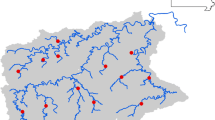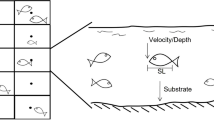Synopsis
We estimated the rate of energy consumed and expended by 43 juvenile smallmouth bass, Micropterus dolomieu, videotaped in the North Anna River during 1991. Habitat data were also collected in the areas where each individual was videotaped. The net rate of energy gained (J·min−1) increased as water depths decreased and mean water-column velocities increased. This relationship remained statistically significant even when we assumed that consumption was as little as 40% of our original estimates, and that respiratory costs were three times higher than we suspected. The net rate of energy gained by juvenile smallmouth bass was only affected by the characteristics of the area that they searched and not the foraging tactics they employed.
Similar content being viewed by others
References cited
Angermeier, P.L. 1992. Predation by rock bass on other stream fishes: experimental effects of depth and cover. Env. Biol. Fish. 34: 171–180.
Bainbridge, R. 1958. The speed of swimming of fish as related to size and to the frequency and amplitude of the tail beat. J. Exp. Biol. 35: 109–133.
Boisclair, D. & M. Tang. 1993. Empirical analysis of the influence of swimming pattern on the net energetic cost of swimming in fishes. J. Fish Biol. 42: 169–183.
Bowen, S.H. 1983. Quantitative description of the diet. pp. 325–336. In: L.A. Nielsen & D.L. Johnson (ed.) Fisheries Techniques, American Fisherires Society, Bethesda.
Buynak, G.L., A.J. Gurzynski & H.W. Mohr, Jr. 1982. Comparison of the food habits of smallmouth bass (Micropterus dolomieui) at two stations on the Susquehanna River. Proc. Pa. Acad. Sci. 56: 127–132.
Cummins, K.W. & J.C. Wuycheck. 1971. Caloric equivalents for investigations in ecological energetics. Verh. Inter. Verein. Theor. Ang. Limnol. 18: 1–158.
Easton, R.S. & D.J. Orth. 1992. Ontogenetic diet shifts of age-0 smallmouth bass (Micropterus dolomieu Lacepède) in the New River, West Virginia, USA. Ecol. Fresh. Fish 1: 86–98.
Elliott, J.M. 1976. Energy losses in the waste products of brown trout (Salmo trutta L.). J. Anim. Ecol. 45: 561–580.
Facey, D.E. & G.D. Grossman. 1990. The metabolic cost of maintaining position for four North American stream fishes: effects of season and velocity. Physiol. Zool. 63: 757–776.
Fausch, K.D. 1984. Profitable stream positions for salmonids: relating specific growth rate to net energy gain. Can. J. Zool. 62: 441–451.
Forstner, H. & W. Wieser. 1990. Patterns of routine swimming and metabolic rate in juvenile cyprinids at three temperatures: analysis with a respirometer-activity-monitoring-system. J. Comp. Physiol. B160: 71–76.
Godin, J.J. & R.W. Rangeley. 1989. Living in the fast lane: effects of cost of locomotion on foraging behaviour in juvenile Atlantic salmon. Anim. Behav. 37: 943–954.
Gore, J.A. & R.D. Judy, Jr. 1981. Predictive models of benthic macroinvertebrate density for use in instream flow studies and regulated flow management. Can. J. Fish. Aquat. Sci. 38: 1363–1370.
Hughes, N.F. & L.M. Dill. 1990. Position choice by drift-feeding salmonids: model and test for arctic grayling (Thymallus arcticus) in subarctic mountain streams, interior Alaska. Can. J. Fish. Aquat. Sci. 47: 2039–2048.
Kondratieff, C. & J.R. Voshell. 1980. Life history and ecology of Stenonema modestum (Banks) (Ephemeroptera: Heptageniidae) in Virginia, USA. Aquat. Insects 2: 177–189.
Lachner, E.A. 1950. Food, growth and habits of fingerling northern smallmouth bass, Micropterus dolomieu dolomieu Lacépède in trout waters of western New York. J. Wildl. Manage. 14: 50–57.
Larimore, R.W. 1975. Visual and tactile orientation of smallmouth bass fry under floodwater conditions. pp. 323–332. In: H. Clepper (ed.) Black Bass Biology and Management, Sport Fishing Institute, Washington, D.C.
Orth, D.J. & O.E. Maughn. 1983. Microhabitat preferences of benthic fauna in a woodland stream. Hydrobiologia 106: 157–168.
Pierce, R.J. & T.E. Wissing. 1974. The energy cost of food utilization in the bluegill Lepomis macrochirus. Trans. Amer. Fish. Soc. 103: 38–45.
Power, M.E. 1984. Depth distributions of armored catfish: predator-induced resource avoidance? Ecology 65: 523–528.
Puckett, K.J. & L.M. Dill. 1984. Cost of sustained and burst swimming to juvenile coho salmon (Oncorhynchus kisutch). Can. J. Fish. Aquat. Sci. 41: 1546–1551.
Rice, J.A., J.E. Breck, S.M. Bartell & J.F. Kitchell. 1983. Evaluating the constraints of temperature, activity and consumption on growth of largemouth bass. Env. Biol. Fish. 9: 263–275.
Sabo, M.J. & D.J. Orth. 1994. Temporal variation in microhabitat use by age-0 smallmouth bass in the North Anna River, Virginia. Trans. Amer. Fish. Soc. 123: 733–746.
Sabo, M.J. & D.J. Orth. 1995. Growth of age-0 smallmouth bass (Micropterus dolomieu Lacépède): interactive effect of temperature, spawning date, and growth autocorrelation. Ecol. Fresh. Fish 4: 28–36.
Schlosser, I.J. 1987. The role of predation in age- and size-related habitat use by stream fishes. Ecology 68: 651–659.
Shuter, B.J. & J.R. Post. 1990. Climate, population viability, and the zoogeography of temperate fishes. Trans. Amer. Fish. Soc. 119: 314–336.
Simmons, G.M. & J.R. Voshell, 1978. Pre- and post-impoundment benthic macroinvertebrate communities of the North Anna River. pp. 45–61. In: J. Cairns Jr., E.F. Benfield & J.R. Webster (ed.) Current Perspectives on River-reservoir Ecosystems. North American Benthological Society, Lawrence.
Simonson, T.D. & W.A. Swenson. 1990. Critical stream velocities for young-of-the-year smallmouth bass in relation to habitat use. Trans. Amer. Fish. Soc. 119: 902–909.
Smit, H. 1965. Some experiments on the oxygen consumption of goldfish (Carassius auratus L.) in relation to swimming speed. Can. J. Zool. 59: 882–889.
Stites, D.L. & A.C. Benke. 1989. Rapid growth rates of chironomids in three habitats of a subtropical blackwater river and their implications for P:B ratios. Limnol. Oceanogr. 34: 1278–1289.
Weatherly, A.H., S.C. Rogers, D.G. Pincock & J.R. Patch. 1982. Oxygen consumption of active rainbow trout, Salmo gairdneri, Richardson, derived from electromyograms obtained by radiotelemetry. J. Fish Biol. 20: 479–489.
Webb, P.W. 1991. Composition and mechanics of routine swimming of rainbow trout, Oncorhynchus mykiss. Can. J. Fish. Aquat. Sci. 48: 583–590.
Author information
Authors and Affiliations
Rights and permissions
About this article
Cite this article
Sabo, M.J., Orth, D.J. & Pert, E.J. Effect of stream microhabitat characteristics on rate of net energy gain by juvenile smallmouth bass, Micropterus dolomieu . Environ Biol Fish 46, 393–403 (1996). https://doi.org/10.1007/BF00005019
Received:
Accepted:
Issue Date:
DOI: https://doi.org/10.1007/BF00005019




